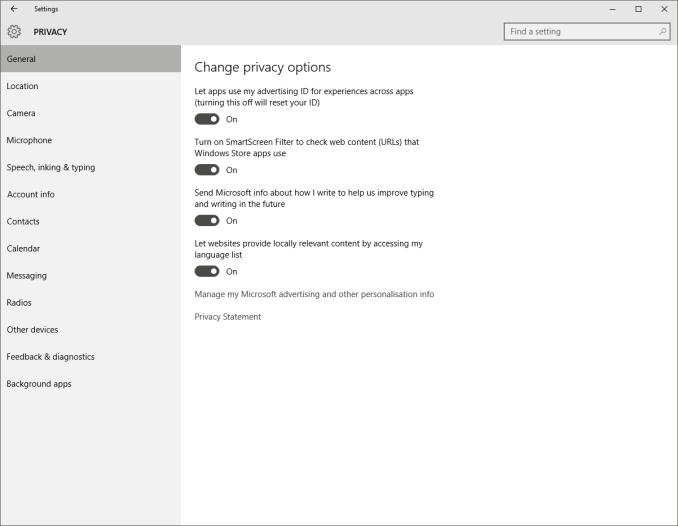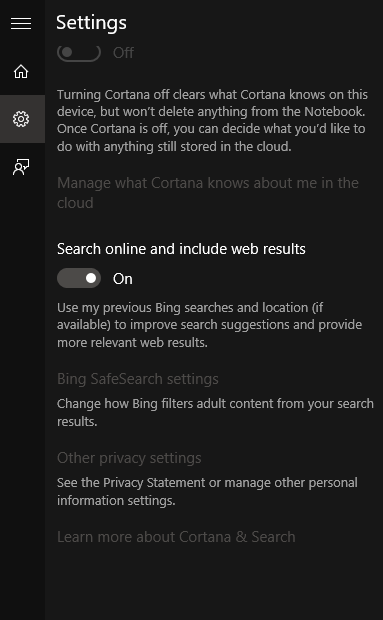The Windows 10 Review: The Old & New Face of Windows
by Brett Howse on August 25, 2015 8:00 AM EST- Posted in
- Operating Systems
- Microsoft
- Windows 10
Windows 10 Privacy
There has been an enormous amount of talk lately about Windows 10’s privacy settings, and what this means for people who use Windows 10. Yes, Windows 10 does do more with your data than any previous version of Windows, but that is not always a bad thing.
Many of the services which are designed to help you are going to require access to your information in order to function. Cortana can’t let you know about an upcoming event if it doesn’t have access to your calendar. The state of the world in 2015 is that in order for these types of services to work, you have to let them have access to your information. Cortana, as an example, does not live in a vacuum, and these same types of features are certainly prevalent on other operating systems too. Google Now is a great example of a service which people have come to really appreciate, and the very things they appreciate are based on the fact that it has a lot of access to your personal information.
Any person that is concerned about what Microsoft is collecting and how they are using it should really start by reading their Privacy Statement and getting an understanding about what is collected and what it is used for. Some of this is obvious, like Microsoft needs to provide access to your information if requested by a court order. Microsoft is not above the law. Some of it is not as obvious though, like what is your advertising ID.
Windows 10 is a free upgrade, but regardless of Windows 10 many of the services which are associated with it are free as well, such as outlook.com. Microsoft is paying for these services with advertising much like many other web services. In order to provide you with more relevant ads, you have an advertising ID associated with your account. Some people may not like this, and the privacy settings to turn this off can be found in Settings under the Privacy header. There are also more settings within Edge which let you enable Do Not Track requests and more.
Edge Privacy Settings
Search Privacy Settings
A lot of the discussion about privacy is how so much of this is on be default, and that is certainly true. If you choose Express Settings during setup, a lot of this is enabled. You can also choose Custom and choose what you want turned on during setup. Other services like Cortana are Opt-In, and will prompt you for consent the first time you try to access it. If you don’t want Cortana to access your information, please turn Cortana off.
For people that would like to read more about the individual features of Windows 10 and their privacy concerns, Microsoft has a Windows 10 Privacy FAQ page which you can take a look at. This goes over all of the features, what they do, and how you can turn them off. I really encourage users that are concerned to read this over.
Let’s be honest here for a minute though. The privacy concerns are certainly not overblown, but for most people, they will make the trade-off of less privacy if it means an improved experience. The textbook example here is advertising, where in order to deliver relevant ads to the user (or rather not serve them useless ads) the ad service must be able to learn something about the user and their preferences. Microsoft is certainly not the first company to do this, and Windows 10 is not even the first version of Windows where this is an issue. Many of these same concerns could be had with Windows 8 as well. But I think services like Cortana that are so proactive can touch a nerve with the privacy conscious and that is 100% fine. If you are concerned, the best thing to do is to read the privacy statement and adjust your settings accordingly.













293 Comments
View All Comments
minijedimaster - Tuesday, August 25, 2015 - link
^TROLL^galta - Tuesday, August 25, 2015 - link
Maybe... Or maybe you miss basic reading skills. Who could know?Michael Bay - Tuesday, August 25, 2015 - link
Four transitions as of now for me, two from 7 and two from 8.Aside from some video driver issues on nV desktop and intel notebook right after installing, it was a remarkably smooth sailing.
andrewaggb - Tuesday, August 25, 2015 - link
I've upgraded over 10 pc's, only 1 had a problem and automatically rolled by to 8.1 (I ended up doing a fresh install of 10 on this machine). Some were running 7 and most were running 8.1kmmatney - Tuesday, August 25, 2015 - link
Same here - 2 computer from Windows 8.1 (one a tablet), and 3 computers from Windows 7. For 2 of the Windows 7 machines, I was able to upgrade from 32-bit Windows 7 to 64-bit. That was the main reason why I took the free upgrade - to go to 64-bit. There are certainly a few things that annoy me, but overall I can't complain. Funnily enough, the one system where I don't like the upgrade is my tablet - it seems way too laggy. Part of that may be that it still seems to be constantly updating itself.Michael Bay - Wednesday, August 26, 2015 - link
My tablet is M80ta, so I have no real use for x64 on ot. Runs well, I was pleasantly surprised when it understood that I want stilus input when I got it out.If anything, I wish Brett would write more about the tablet side of 10, which became much better compared to 8.
khanikun - Wednesday, August 26, 2015 - link
Win 10 sucks on my Surface 3. Seems fine on my Surface Pro 3. Not much to say about the SP3, but it really feels like I'm getting beta updates on my Surface 3. When I first got it, it was pretty junky. The touchscreen seemed to lag and I'd have to touch it a few times to get it to start registering that I was well...touching it. That was on Win 8 or whatever version came stock, I don't even remember.I went to Win 10 and not much change. Then an update came and it worked great. No issues with the touchscreen. A couple weeks ago, the problem came back again with another update. Also touch seems to not register very well at the taskbar. Which was a non-issue with Win 8.
Either way, rolling back to Win 8.1. I hate that the power button is in the start menu, cause on a 1080p screen that's only 10-12", it's ridiculously small. I also hate that I can't pick/choose what updates I want. On Win 10 Pro, I can delay updates, but I can't pick/choose. So back to 8.1.
Michael Bay - Wednesday, August 26, 2015 - link
Have you considered turning your unit to warranty service? Non-registering touch is itself a reason enough.chrome_slinky - Wednesday, August 26, 2015 - link
It really is ANNOYING to see people call the "upgrade" free. It is not. It is a license trade - NOTHING MORE. In 30 days from "upgrading" you can no longer use the key for the previous OS to go back.Brett Howse - Wednesday, August 26, 2015 - link
That's not correct you can always use your key to go back, but after 30 days the automated recovery to allow you to go back removes the old Windows.old folder it saved during the upgrade to allow you to roll back from Windows 10 to 7 or 8.1. You seem to be a bit confused there so sorry about not making it more clear in the article. You would have to delete your partition and reinstall 7/8.1 with the old key.